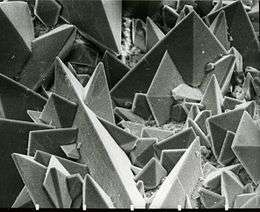Weddellite
| Weddellite | |
|---|---|
|
Scanning Electron Micrograph of the surface of a kidney stone showing crystals of weddellite emerging from the amorphous central part of the stone. Horizontal length of the picture represents 0.5 mm of the figured original. | |
| General | |
| Category | Organic mineral |
| Formula (repeating unit) | CaC2O4·2H2O |
| Strunz classification | 10.AB.40 |
| Crystal system | Tetragonal |
| Crystal class |
Dipyramidal (4/m) H-M symbol: (4/m) |
| Space group | I4/m |
| Unit cell | a = 12.371, c = 7.357 [Å]; Z = 8 |
| Identification | |
| Color | Colorless to white, may be yellowish brown to brown from impurities |
| Crystal habit | Isolated crystals, may be corroded |
| Twinning | Single or multiple |
| Cleavage | Good on {010} |
| Fracture | Conchoidal |
| Mohs scale hardness | 4 |
| Luster | Vitreous |
| Streak | White |
| Diaphaneity | Transparent |
| Specific gravity | 1.94 |
| Optical properties | Uniaxial (+) |
| Refractive index | nω = 1.523 nε = 1.544 |
| Birefringence | δ = 0.021 |
| Other characteristics | Dehydrates on air exposure |
| References | [1][2][3] |
Weddellite (CaC2O4·2H2O) is a mineral form of calcium oxalate named for occurrences of millimeter-sized crystals found in bottom sediments of the Weddell Sea, off Antarctica. Occasionally, weddellite partially dehydrates to whewellite, forming excellent pseudomorphs of grainy whewellite after weddellite's short tetragonal dipyramids. It was first described in 1942.[1]
Structural properties
Weddellite, or calcium oxalate dihydrate, crystallises in a tetragonal system: the classic crystal shape is the eight-face bipyramid. Using bright field microscopy, the weddellite crystals are recognised easily by their shape, reminiscent of a postal envelope. More complex shapes of weddellite are possible; the dumbbell shape is not rare and has no precise angles or sides. This form is, in reality, a microcrystalline agglomerate that takes the shape of a biconcave disc. Weddellite crystals are poorly birefringent and do not show any interference pattern under polarised light.
Biological role
Weddellite crystals are usually of little clinical value. Together, whewellite and weddellite are the most common renal calculi.
Occurrence
Weddellite occurs as authigenic crystals in sea floor mud. It also has been reported in peat bearing sediments and in calcite-bearing lacustrine sediments. It occurs with whewellite, urea, phosphammite and aphthitalite.[2]
